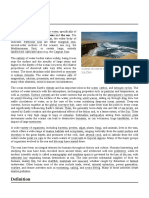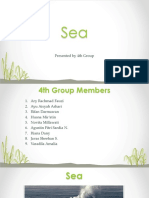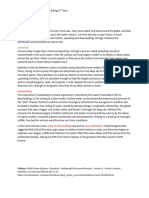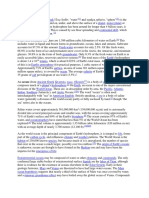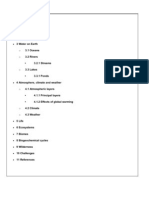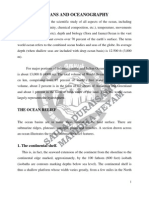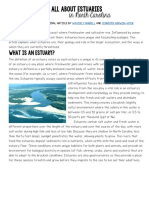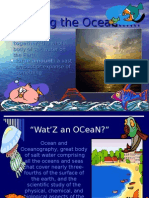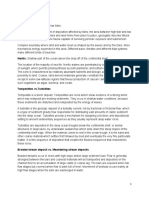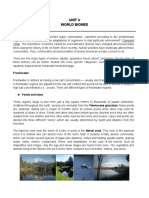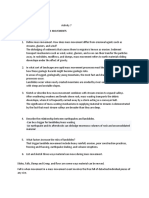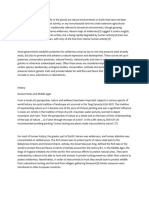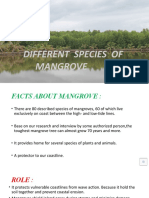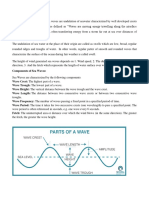Sea
Sea
Uploaded by
hannaslominska.2008Copyright:
Available Formats
Sea
Sea
Uploaded by
hannaslominska.2008Original Title
Copyright
Available Formats
Share this document
Did you find this document useful?
Is this content inappropriate?
Copyright:
Available Formats
Sea
Sea
Uploaded by
hannaslominska.2008Copyright:
Available Formats
A sea is a large body of salty water. There are particular seas and the sea.
The sea commonly refers to
the ocean, the wider body of seawater. Particular seas are either marginal seas, second-order sections of
the oceanic sea (e.g. the Mediterranean Sea), or certain large, nearly landlocked bodies of water.
The salinity of water bodies varies widely, being lower near the surface and the mouths of large rivers
and higher in the depths of the ocean; however, the relative proportions of dissolved salts vary little
across the oceans. The most abundant solid dissolved in seawater is sodium chloride. The water also
contains salts of magnesium, calcium, potassium, and mercury, amongst many other elements, some in
minute concentrations.
The ocean moderates Earth's climate and has important roles in the water, carbon, and nitrogen cycles.
The surface of water interacts with the atmosphere, exchanging properties such as particles and
temperature, as well as currents. Surface currents are the water currents that are produced by the
atmosphere's currents and its winds blowing over the surface of the water, producing wind waves,
setting up through drag slow but stable circulations of water, as in the case of the ocean sustaining deep-
sea ocean currents. Deep-sea currents, known together as the global conveyor belt, carry cold water
from near the poles to every ocean and significantly influence Earth's climate. Tides, the generally twice-
daily rise and fall of sea levels, are caused by Earth's rotation and the gravitational effects of the Moon
and, to a lesser extent, of the Sun. Tides may have a very high range in bays or estuaries. Submarine
earthquakes arising from tectonic plate movements under the oceans can lead to destructive tsunamis,
as can volcanoes, huge landslides, or the impact of large meteorites.
A wide variety of organisms, including bacteria, protists, algae, plants, fungi, and animals, lives in the
seas, which offers a wide range of marine habitats and ecosystems, ranging vertically from the sunlit
surface and shoreline to the great depths and pressures of the cold, dark abyssal zone, and in latitude
from the cold waters under polar ice caps to the warm waters of coral reefs in tropical regions. Many of
the major groups of organisms evolved in the sea and life may have started there.
The seas have been an integral element for humans throughout history and culture. Humans harnessing
and studying the seas have been recorded since ancient times and evidenced well into prehistory, while
its modern scientific study is called oceanography and maritime space is governed by the law of the sea,
with admiralty law regulating human interactions at sea. The seas provide substantial supplies of food
for humans, mainly fish, but also shellfish, mammals and seaweed, whether caught by fishermen or
farmed underwater. Other human uses of the seas include trade, travel, mineral extraction, power
generation, warfare, and leisure activities such as swimming, sailing, and scuba diving. Many of these
activities create marine pollution.
You might also like
- The Ocean Answer BookDocument545 pagesThe Ocean Answer BookKira Koorsen100% (4)
- PIANC - Mitigation of Tsunami Disasters in Ports - Wg5354Document114 pagesPIANC - Mitigation of Tsunami Disasters in Ports - Wg5354Ryan ColemanNo ratings yet
- SeaDocument1 pageSeaTPA LVBD PARAMAKUDINo ratings yet
- SeaDocument21 pagesSeaLakshmish GopalNo ratings yet
- Sea (With The Definite Article) Is The Interconnected System of The Earth'sDocument2 pagesSea (With The Definite Article) Is The Interconnected System of The Earth'sPei LingNo ratings yet
- List of Seas Sea (Disambiguation) Seas (Disambiguation) The Sea (Disambiguation) Ocean Sea (Novel)Document2 pagesList of Seas Sea (Disambiguation) Seas (Disambiguation) The Sea (Disambiguation) Ocean Sea (Novel)megawhat115No ratings yet
- Sea Refers To A Large Body of Salty Water, Specifically Of: Coastal Sea Waves at Paracas National Reserve, Ica, PeruDocument44 pagesSea Refers To A Large Body of Salty Water, Specifically Of: Coastal Sea Waves at Paracas National Reserve, Ica, PeruNirmal BhowmickNo ratings yet
- Exploring The Vastness of Space An Overview of Key Concepts and DiscoveriesDocument4 pagesExploring The Vastness of Space An Overview of Key Concepts and Discoveriesemranhossan960No ratings yet
- SeaDocument13 pagesSeajackNo ratings yet
- Sea - WikipediaDocument45 pagesSea - WikipediaMGR001No ratings yet
- Animal Ecology-Unit3-4Document11 pagesAnimal Ecology-Unit3-4devilalshingh9525No ratings yet
- Presented by 4th GroupDocument15 pagesPresented by 4th GroupsajNo ratings yet
- Online AssignmentDocument9 pagesOnline AssignmentgeethaNo ratings yet
- Online Assignment PreethuiDocument9 pagesOnline Assignment PreethuigeethaNo ratings yet
- Geological OceanographyDocument5 pagesGeological OceanographyFahimaNo ratings yet
- Chap 8 Physical GeoDocument3 pagesChap 8 Physical GeoJuliana Mae FabrigarNo ratings yet
- Understanding The Oceans' Crucial Role in Earth's EcosystemDocument3 pagesUnderstanding The Oceans' Crucial Role in Earth's Ecosystemahhhyannn124No ratings yet
- High School Earth Science 14-26Document529 pagesHigh School Earth Science 14-26Andrei PopaNo ratings yet
- 3rd ModuleDocument25 pages3rd ModuleLittleJockeyNo ratings yet
- NotesDocument4 pagesNotesLokesh OriginalsNo ratings yet
- SeaDocument1 pageSeaLee TingNo ratings yet
- Whatisan EstuaryDocument27 pagesWhatisan EstuaryAgus RomadhonNo ratings yet
- SeaDocument12 pagesSeaEa RLNo ratings yet
- Currents and Marine LifeDocument1 pageCurrents and Marine LifeabdulbaiczariffainnieNo ratings yet
- Oceans and Coral ReefsDocument6 pagesOceans and Coral ReefsHarsh BajajNo ratings yet
- Article Talk Read Edit View History: ToolsDocument54 pagesArticle Talk Read Edit View History: ToolsVictoriano OrdonioNo ratings yet
- Angel 5Document2 pagesAngel 5anon_874156217No ratings yet
- EnvironmentDocument19 pagesEnvironmentKrunal ChoreyNo ratings yet
- Online AssignmentDocument12 pagesOnline AssignmentsavithasanthoshNo ratings yet
- ResourcesDocument5 pagesResourcesJhanvipooNo ratings yet
- Rosalie Brillantes AsignmentDocument6 pagesRosalie Brillantes AsignmentTata Duero LachicaNo ratings yet
- Oceanic Crust Continental Shelf Continental Slope Continental Rise Tectonics Sea Level Rivers Energy Waves CurrentsDocument6 pagesOceanic Crust Continental Shelf Continental Slope Continental Rise Tectonics Sea Level Rivers Energy Waves CurrentsYadah AlindayoNo ratings yet
- Enviromental Oceans and FisheiresDocument11 pagesEnviromental Oceans and FisheiresefernandezNo ratings yet
- OceanDocument8 pagesOceanEa RLNo ratings yet
- Deep Sea Life:: On The Edge of The AbyssDocument28 pagesDeep Sea Life:: On The Edge of The AbyssNatasha RangelNo ratings yet
- Natsci 13Document9 pagesNatsci 13Yuji KojimaNo ratings yet
- OceanDocument39 pagesOceanNirmal BhowmickNo ratings yet
- Oceans and OceanographyDocument13 pagesOceans and OceanographymkprabhuNo ratings yet
- IX Class Chap 3 Social StudiesDocument5 pagesIX Class Chap 3 Social StudiesBNo ratings yet
- Text Tuesday Estuaries in NC MDocument5 pagesText Tuesday Estuaries in NC Mapi-3309611620% (1)
- Upload 1Document14 pagesUpload 1Rp karanNo ratings yet
- SeaDocument2 pagesSeanarvasaka.cbaNo ratings yet
- Marine Ecosystem - Britannica Online EncyclopediaDocument14 pagesMarine Ecosystem - Britannica Online EncyclopediaKhadija IkramNo ratings yet
- Grasping The OceanDocument17 pagesGrasping The Oceansapphire09No ratings yet
- O132 CO1 Littoral. Between High and Low TidesDocument12 pagesO132 CO1 Littoral. Between High and Low TidesEunicia BascoNo ratings yet
- Written Exercise 5Document6 pagesWritten Exercise 5John Rey LayderosNo ratings yet
- Marine Science. An Illustrated Guide To Science - MarSci - IllustDocument257 pagesMarine Science. An Illustrated Guide To Science - MarSci - IllustAndres Sanjuan67% (3)
- Ocean Resources: Fishing FactsDocument16 pagesOcean Resources: Fishing Factskartik_rajaniNo ratings yet
- Unit V BiomesDocument14 pagesUnit V BiomesHyramae CuacoNo ratings yet
- Activity 5Document24 pagesActivity 5juliuspadua1985No ratings yet
- Written Report in EcologyDocument48 pagesWritten Report in EcologyApril50% (2)
- Geoglogy Activity 7Document8 pagesGeoglogy Activity 7Cejay SarzNo ratings yet
- Vertical Structure in Coastal Waters-Fresh Water Run-Off and Tidal MixingDocument51 pagesVertical Structure in Coastal Waters-Fresh Water Run-Off and Tidal MixingCrisencio M. PanerNo ratings yet
- Introduction To Sedimentary Environments: Dr. N. P. NayakDocument14 pagesIntroduction To Sedimentary Environments: Dr. N. P. NayakBaby ChickooNo ratings yet
- UnderstandingEarth-OurOcean 508 0Document16 pagesUnderstandingEarth-OurOcean 508 0Anh Lê HoàngNo ratings yet
- E.M Year 10 Term 2 NotesDocument25 pagesE.M Year 10 Term 2 NotesNANCYNo ratings yet
- MarineBiol Unit 3Document7 pagesMarineBiol Unit 3YashNo ratings yet
- All About Pacific Ocean: A Kid's Guide to the World's Largest Ocean: Educational Books For Kids, #11From EverandAll About Pacific Ocean: A Kid's Guide to the World's Largest Ocean: Educational Books For Kids, #11No ratings yet
- Seabed: StructureDocument13 pagesSeabed: StructureSebastian GhermanNo ratings yet
- Group 5 TidesDocument23 pagesGroup 5 TidesJayson ReyNo ratings yet
- WildDocument2 pagesWildhannaslominska.2008No ratings yet
- Honk KongDocument3 pagesHonk Konghannaslominska.2008No ratings yet
- RussiaDocument2 pagesRussiahannaslominska.2008No ratings yet
- ForestDocument2 pagesForesthannaslominska.2008No ratings yet
- High Note SBK 3 POL 9788378827931 EPanel-ePanel1Document194 pagesHigh Note SBK 3 POL 9788378827931 EPanel-ePanel1hannaslominska.2008No ratings yet
- Flaky Sourdough Pie Crust (Sweet or Savory)Document2 pagesFlaky Sourdough Pie Crust (Sweet or Savory)hannaslominska.2008No ratings yet
- Magallona V Ermita Case DigestDocument2 pagesMagallona V Ermita Case DigestSerkay Gobs100% (1)
- FB Quick Link (7 Chap Book Wow)Document2 pagesFB Quick Link (7 Chap Book Wow)SHESASHTHINY A/P MANICKA RAO MoeNo ratings yet
- Suffolk County Comprehensive Water Resources Management Plan (Executive Summary)Document40 pagesSuffolk County Comprehensive Water Resources Management Plan (Executive Summary)RiverheadLOCALNo ratings yet
- Data ConsumptionDocument84 pagesData ConsumptionfaisalNo ratings yet
- Mangrove SsssssDocument49 pagesMangrove SsssssWeendy Gayle T. VelilaNo ratings yet
- Longshore Sediment Transport Pattern Along Romanian Danube Delta CoastDocument13 pagesLongshore Sediment Transport Pattern Along Romanian Danube Delta CoastgabionsNo ratings yet
- The Quran On Seas and Rivers 214 enDocument3 pagesThe Quran On Seas and Rivers 214 enshahraashidNo ratings yet
- Jetties and GroynesDocument50 pagesJetties and Groynesabhisang32100% (1)
- Airspace ChartDocument1 pageAirspace ChartYusuf SöylerNo ratings yet
- CBSE Class 7 Geography Chapter 5 Notes - WaterDocument7 pagesCBSE Class 7 Geography Chapter 5 Notes - WaterTottleNo ratings yet
- How-Tsunamis-Work Activity 5 2° GradeDocument2 pagesHow-Tsunamis-Work Activity 5 2° GradejoshuabaezNo ratings yet
- Coastal ProcessesDocument44 pagesCoastal Processesamabelle sibugNo ratings yet
- Introduction To Physical OceanographyDocument4 pagesIntroduction To Physical OceanographyM Farid Geonova100% (1)
- Phil WetlandsDocument41 pagesPhil WetlandsEmie Grace Perez MesolisNo ratings yet
- Tidal Predictions For Georgetown GuyanaDocument7 pagesTidal Predictions For Georgetown GuyanahutsonianpNo ratings yet
- Coastal Processes and LandformsDocument43 pagesCoastal Processes and LandformsPoornimaNo ratings yet
- Arquitectura de Facies de Los Deltas Cuaternarios Del Río Llobregat, Barcelona, EspañaDocument4 pagesArquitectura de Facies de Los Deltas Cuaternarios Del Río Llobregat, Barcelona, EspañaAlexandra Yennyfer Espinoza PeraltaNo ratings yet
- 微臣教育 TOEFL听力方法论讲解Document7 pages微臣教育 TOEFL听力方法论讲解chaunceyrollestonNo ratings yet
- Brazilian Beach Systems: Andrew D. Short Antonio Henrique Da F. Klein EditorsDocument624 pagesBrazilian Beach Systems: Andrew D. Short Antonio Henrique Da F. Klein EditorsTúlio SalesNo ratings yet
- Spalding 2007Document11 pagesSpalding 2007Amanda CoraçãoNo ratings yet
- Chemistry FoundationDocument7 pagesChemistry Foundationkhalison khalidNo ratings yet
- DRRR PresentationDocument9 pagesDRRR PresentationSofia Anne JoseNo ratings yet
- 1 TypesDocument5 pages1 TypesOfentse Boat bouyNo ratings yet
- Coasts PPT For Year 11Document62 pagesCoasts PPT For Year 11ife100% (1)
- Geoglogy Activity 7Document8 pagesGeoglogy Activity 7Cejay SarzNo ratings yet
- Ecosystem DiversityDocument1 pageEcosystem Diversityliezl ann g. valdezNo ratings yet
- Week 2 SimDocument9 pagesWeek 2 SimJEZUE REMULTANo ratings yet
- Tarazona Et Al. 2003 Overview and Challenges of Marine BiodiversityDocument26 pagesTarazona Et Al. 2003 Overview and Challenges of Marine BiodiversitySonia ValleNo ratings yet
- Design of GroinsDocument18 pagesDesign of GroinsSatya S AtluriNo ratings yet






